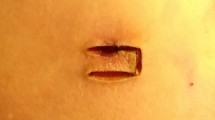Abstract
Purpose
Skin disorders are the most common stoma-related complications after temporary diverting loop ileostomy with proctectomy. The aim of the present study was to investigate risk factors for skin disorders associated with temporary ileostomy construction.
Methods
A total of 185 consecutive patients who underwent curative proctectomy with temporary diverting loop ileostomy for rectal malignancies at a single comprehensive cancer center between 2013 and 2018 were collected and analyzed.
Results
The most frequent stoma-related complications were skin disorders (n = 62, 33.5%), followed by mucocutaneous separation (n = 38, 20.5%) and high-output stoma (n = 34, 18.4%). Patients with skin disorders had a higher median body mass index (BMI; 22.4 vs. 21.3 kg/m2, P = 0.002) and lower stoma height (16 vs. 20 mm, P < 0.001) than those without skin disorders. According to a multivariable logistic regression analysis, independent predictors of skin disorders included overweight (median BMI ≥ 25 kg/m2 [odds ratio = 3.6, 95% confidence interval: 1.5–8.6], P = 0.004) and lower stomal height (median stoma height < 20 mm [odds ratio = 3.2, 95% confidence interval: 1.6–6.3], P < 0.001).
Conclusion
Overweight and lower stoma height are correlated with the presence of skin disorders. Construction of a well-elevated stoma can reduce skin disorders associated with temporary ileostomy construction.

Similar content being viewed by others
References
Dehni N, Schlegel RD, Cunningham C, Guiguet M, Tiret E, Parc R. Influence of a defunctioning stoma on leakage rates after low colorectal anastomosis and colonic J pouch-anal anastomosis. Br J Surg. 1998;85:1114–7.
Marusch F, Koch A, Schmidt U, Geibetaler S, Dralle H, Saeger HD, et al. Value of a protective stoma in low anterior resections for rectal cancer. Dis Colon Rectum. 2002;45:1164–71.
Gastinger I, Marusch F, Steinert R, Wolff S, Koeckerling F, Lippert H. Protective defunctioning stoma in low anterior resection for rectal carcinoma. Br J Surg. 2005;92:1137–42.
Lefebure B, Tuech JJ, Bridoux V, Costaglioli B, Scotte M, Teniere P, et al. Evaluation of selective defunctioning stoma after low anterior resection for rectal cancer. Int J Colorectal Dis. 2008;23:283–8.
Klink CD, Lioupis K, Binnebosel M, Kaemmer D, Kozubek I, Grommes J, et al. Diversion stoma after colorectal surgery: loop colostomy or ileostomy? Int J Colorectal Dis. 2011;26:431–6.
Edwards DP, Leppington-Clarke A, Sexton R, Heald RJ, Moran BJ. Stoma-related complications are more frequent after transverse colostomy than loop ileostomy: a prospective randomized clinical trial. Br J Surg. 2001;88:360–3.
Gooszen AW, Geelkerken RH, Hermans J, Lagaay MB, Gooszen HG. Temporary decompression after colorectal surgery: randomized comparison of loop ileostomy and loop colostomy. Br J Surg. 1998;85:76–9.
Wu X, Lin G, Qiu H, Xiao Y, Wu B, Zhong M. Loop ostomy following laparoscopic low anterior resection for rectal cancer after neoadjuvant chemoradiotherapy. Eur J Med Res. 2018;23:24.
Persson E, Berndtsson I, Carlsson E, Hallen AM, Lindholm E. Stoma-related complications and stoma size—a 2-year follow up. Colorectal Dis. 2010;12:971–6.
Scarpa M, Ruffolo C, Boetto R, Pozza A, Sadocchi L, Angriman I. Diverting loop ileostomy after restorative proctocolectomy: predictors of poor outcome and poor quality of life. Colorectal Dis. 2010;12:914–20.
Shiraishi T, Nishizawa Y, Nakajima M, Kado R, Ikeda K, Tsukada Y, et al. Risk factors for the incidence and severity of peristomal skin disorders defined using two scoring systems. Surg Today. 2020;50:284–91.
Maydick-Youngberg D. A descriptive study to explore the effect of peristomal skin complications on quality of life of adults with a permanent ostomy. Ostomy Wound Manage. 2017;63:10–23.
Lyon CC, Smith AJ, Griffiths CE, Beck MH. The spectrum of skin disorders in abdominal stoma patients. Br J Dermatol. 2000;143:1248–60.
Braumann C, Muller V, Knies M, Aufmesser B, Schwenk W, Koplin G. Complications after ostomy surgery: emergencies and obese patients are at risk-data from the berlin ostomy study (BOSS). World J Surg. 2019;43:751–7.
Chun LJ, Haigh PI, Tam MS, Abbas MA. Defunctioning loop ileostomy for pelvic anastomoses: predictors of morbidity and nonclosure. Dis Colon Rectum. 2012;55:167–74.
Arumugam PJ, Bevan L, Macdonald L, Watkins AJ, Morgan AR, Beynon J, et al. A prospective audit of stomas—analysis of risk factors and complications and their management. Colorectal Dis. 2003;5:49–52.
Miyo M, Takemasa I, Ikeda M, Tujie M, Hasegawa J, Ohue M, et al. The influence of specific technical maneuvers utilized in the creation of diverting loop-ileostomies on stoma-related morbidity. Surg Today. 2017;47:940–50.
Kanda Y. Investigation of the freely available easy-to-use software “EZR” for medical statistics. Bone Marrow Transpl. 2013;48:452–8.
Cottam J, Richards K, Hasted A, Blackman A. Results of a nationwide prospective audit of stoma complications within 3 weeks of surgery. Colorectal Dis. 2007;9:834–8.
Parmar KL, Zammit M, Smith A, Kenyon D, Lees NP. A prospective audit of early stoma complications in colorectal cancer treatment throughout the Greater Manchester and Cheshire colorectal cancer network. Colorectal Dis. 2011;13:935–8.
Harilingam M, Sebastian J, Twum-Barima C, Boshnaq M, Mangam S, Khushal A, et al. Patient-related factors influence the risk of developing intestinal stoma complications in early post-operative period. ANZ J Surg. 2017;87:E116–20.
Acknowledgements
We sincerely thank the WOC nurses who provided patient care: Hitomi Kojima, Terumi Sasaki, and Mayumi Agata (Department of Nursing, the Aichi Cancer Center Hospital, Aichi, Japan). We also thank PROEDIT JAPAN for proofreading our draft.
Funding
The authors received no specific funding for this work.
Author information
Authors and Affiliations
Corresponding author
Ethics declarations
Conflict of interest
The authors declare that no competing interests exist.
Additional information
Publisher's Note
Springer Nature remains neutral with regard to jurisdictional claims in published maps and institutional affiliations.
Rights and permissions
About this article
Cite this article
Maeda, S., Ouchi, A., Komori, K. et al. Risk factors for peristomal skin disorders associated with temporary ileostomy construction. Surg Today 51, 1152–1157 (2021). https://doi.org/10.1007/s00595-020-02209-x
Received:
Accepted:
Published:
Issue Date:
DOI: https://doi.org/10.1007/s00595-020-02209-x




